A Review of Microfiber-Based Temperature Sensors
Abstract
:1. Introduction
2. Microfiber Manufacture
3. MF Sensor Properties
3.1. Low Loss
3.2. Large Evanescent Field
3.3. Confinement
3.4. Mechanical Strength
3.5. Flexibility
4. Sensor Parameters
- Sensitivity (S) represents the change in the parameter used for detection as a result of a change in the parameter being monitored. For temperature sensing, this will either be in units (a) nm/°C when monitoring the shift in wavelength, or (b) dB/°C when monitoring the change in the power.
- Resolution (R) is the smallest detectable change in the parameter used for detection. The resolution is related to the precision with which the measurement is made and hence is usually affected by the specifications of the detection system.
- Detection limit (DL) represents the minimum quantity change in the parameter to monitor that can be detected by the sensor. It is related to S and R by:
- Response time () is typically the time required to rise to 90% of the final value, measured from the onset of the step input change in the parameter to monitor. It is frequently measured in s.
- Dynamic range (DR) is the range of values of the parameter under examination, which can be measured by the sensor.
- Repeatability is the variation in the detection parameter for measurements taken on the same sample under the same experimental conditions. It is an indicator of the agreement between two different measurements carried out on the same sample.
5. Nonresonant Micro/Nanofiber Temperature Sensors
5.1. Functionally Micro/Nanofibers Surface
5.2. Microfiber Coupler
5.3. Grating-Based Micro/Nanofibers
5.3.1. Microfiber Bragg Gratings
5.3.2. Microfiber Long Period Grating
5.4. Interferometer-Based Micro/Nanofibers
6. Resonant-Based Micro/Nanofiber Temperature Sensors
6.1. Loop Resonator (LR)
6.1.1. Manufacture and Properties
6.1.2. LR Temperature Sensor
6.2. Knot Resonator (KR)
6.2.1. Manufacture and Properties
6.2.2. KR Temperature Sensors
6.3. Microcoil Resonator (MR)
6.3.1. Manufacture and Properties
6.3.2. MR Temperature Sensor
7. Conclusions
Author Contributions
Conflicts of Interest
References
- Brambilla, G.; Finazzi, V.; Richardson, D.J. Ultra-low-loss optical fiber nanotapers. Opt. Express 2004, 12, 2258–2263. [Google Scholar] [CrossRef] [PubMed]
- Brambilla, G. Optical fibre nanotaper sensors. Opt. Fiber Technol. 2010, 16, 331–342. [Google Scholar] [CrossRef]
- Brambilla, G.; Xu, F.; Horak, P.; Jung, Y.; Koizumi, F.; Sessions, N.P.; Koukharenko, E.; Feng, X.; Murugan, G.S.; Wilkinson, J.S.; et al. Optical fiber nanowires and microwires: Fabrication and applications. Adv. Opt. Photonics 2009, 1, 107–161. [Google Scholar] [CrossRef]
- Love, J.D.; Henry, W.M.; Stewart, W.J.; Black, R.J.; Lacroix, S.; Gonthier, F. Tapered single-mode fibres and devices. I. Adiabaticity criteria. IEE Proc. J. Optoelectron. 1991, 138, 343–354. [Google Scholar] [CrossRef]
- Tong, L.; Gattass, R.R.; Ashcom, J.B.; He, S.; Lou, J.; Shen, M.; Maxwell, I.; Mazur, E. Subwavelength-diameter silica wires for low-loss optical wave guiding. Nature 2003, 426, 816–819. [Google Scholar] [CrossRef] [PubMed]
- Stiebeiner, A.; Garcia-Fernandez, R.; Rauschenbeutel, A. Design and optimization of broadband tapered optical fibers with a nanofiber waist. Opt. Express 2010, 18, 22677–22685. [Google Scholar] [CrossRef] [PubMed]
- Baker, C.; Rochette, M. A generalized heat-brush approach for precise control of the waist profile in fiber tapers. Opt. Mater. Express 2011, 1, 1065–1076. [Google Scholar] [CrossRef]
- Nagai, R.; Aoki, T. Ultra-low-loss tapered optical fibers with minimal lengths. Opt. Express 2014, 22, 28427–28436. [Google Scholar] [CrossRef] [PubMed]
- Xu, Y.; Fang, W.; Tong, L. Real-time control of micro/nanofiber waist diameter with ultrahigh accuracy and precision. Opt. Express 2017, 25, 10434–10440. [Google Scholar] [CrossRef] [PubMed]
- Mullaney, K.; Correia, R.; Staines, S.E.; James, S.W.; Tatam, R.P. Monitoring techniques for the manufacture of tapered optical fibers. Appl. Opt. 2015, 54, 8531–8536. [Google Scholar] [CrossRef] [PubMed]
- Felipe, A.; Espíndola, G.; Kalinowski, H.J.; Lima, J.A.S.; Paterno, A.S. Stepwise fabrication of arbitrary fiber optic tapers. Opt. Express 2012, 20, 19893–19904. [Google Scholar] [CrossRef] [PubMed]
- Pricking, S.; Giessen, H. Tapering fibers with complex shape. Opt. Express 2010, 18, 3426–3437. [Google Scholar] [CrossRef] [PubMed]
- Leon-Saval, S.G.; Birks, T.A.; Wadsworth, W.J.; Russell, P.S.J.; Mason, M.W. Supercontinuum generation in submicron fibre waveguides. Opt. Express 2004, 12, 2864–2869. [Google Scholar] [CrossRef] [PubMed]
- Clohessy, A.M.; Healy, N.; Murphy, D.F.; Hussey, C.D. Short low-loss nanowire tapers on singlemode fibres. Electron. Lett. 2005, 41, 954–955. [Google Scholar] [CrossRef]
- Brambilla, G.; Xu, F.; Feng, X. Fabrication of optical fibre nanowires and their optical and mechanical characterisation. Electron. Lett. 2006, 42, 517–519. [Google Scholar] [CrossRef]
- Birks, T.A.; Li, Y.W. The shape of fiber tapers. J. Lightw. Technol. 1992, 10, 432–438. [Google Scholar] [CrossRef]
- Jung, Y.; Brambilla, G.; Richardson, D.J. Broadband single-mode operation of standard optical fibers by using a sub-wavelength optical wire filter. Opt. Express 2008, 16, 14661–14667. [Google Scholar] [CrossRef] [PubMed]
- Sumetsky, M. Theory of adiabatic optical fiber and microfiber tapers. In Proceedings of the 2006 Optical Fiber Communication Conference and the National Fiber Optic Engineers Conference, Anaheim, CA, USA, 5–10 March 2006; p. 3. [Google Scholar]
- Sumetsky, M. How thin can a microfiber be and still guide light? Opt. Lett. 2006, 31, 870–872. [Google Scholar] [CrossRef] [PubMed]
- Sumetsky, M.; Dulashko, Y.; Domachuk, P.; Eggleton, B.J. Thinnest optical waveguide: Experimental test. Opt. Lett. 2007, 32, 754–756. [Google Scholar] [CrossRef] [PubMed]
- Fujiwara, M.; Toubaru, K.; Takeuchi, S. Optical transmittance degradation in tapered fibers. Opt. Express 2011, 19, 8596–8601. [Google Scholar] [CrossRef] [PubMed]
- Xu, F.; Brambilla, G. Embedding optical microfiber coil resonators in Teflon. Opt. Lett. 2007, 32, 2164–2166. [Google Scholar] [CrossRef] [PubMed]
- Xiao, L.; Grogan, M.D.; Leon-Saval, S.G.; Williams, R.; England, R.; Wadsworth, W.J.; Birks, T.A. Tapered fibers embedded in silica aerogel. Opt. Lett. 2009, 34, 2724–2726. [Google Scholar] [CrossRef] [PubMed] [Green Version]
- Jung, Y.; Murugan, G.S.; Brambilla, G.; Richardson, D.J. Embedded Optical Microfiber Coil Resonator with Enhanced High-Q. IEEE Photonics Technol. Lett. 2010, 22, 1638–1640. [Google Scholar] [CrossRef]
- Cui, Y.; Shum, P.P.; Wang, G.; Chang, H.; Dinh, X.Q.; Jiang, M.; Humbert, G. Size effect of gold nanoparticles on optical microfiber refractive index sensors. In Proceedings of the 2011 IEEE Sensors Proceedings, Limerick, Ireland, 28–31 October 2011; pp. 371–374. [Google Scholar]
- Brambilla, G.; Payne, D.N. The Ultimate Strength of Glass Silica Nanowires. Nano Lett. 2009, 9, 831–835. [Google Scholar] [CrossRef] [PubMed]
- Li, X.-F.; Wang, B.-L.; Lee, K.Y. Size effects of the bending stiffness of nanowires. J. Appl. Phys. 2009, 105, 074306. [Google Scholar] [CrossRef]
- Black, R.J.; Lacroix, S.; Gonthier, F.; Love, J.D. Tapered single-mode fibres and devices. II. Experimental and theoretical quantification. IEE Proc. J. Optoelectron. 1991, 138, 355–364. [Google Scholar] [CrossRef]
- Díaz-Herrera, N.; Navarrete, M.C.; Esteban, O.; González-Cano, A. A fibre-optic temperature sensor based on the deposition of a thermochromic material on an adiabatic taper. Meas. Sci. Technol. 2004, 15, 353. [Google Scholar] [CrossRef]
- Xue, Y.; Yu, Y.-S.; Yang, R.; Wang, C.; Chen, C.; Guo, J.-C.; Zhang, X.-Y.; Zhu, C.-C.; Sun, H.-B. Ultrasensitive temperature sensor based on an isopropanol-sealed optical microfiber taper. Opt. Lett. 2013, 38, 1209–1211. [Google Scholar] [CrossRef] [PubMed]
- Hernández-Romano, I.; Monzón-Hernández, D.; Moreno-Hernández, C.; Moreno-Hernandez, D.; Villatoro, J. Highly Sensitive Temperature Sensor Based on a Polymer-Coated Microfiber Interferometer. IEEE Photonics Technol. Lett. 2015, 27, 2591–2594. [Google Scholar] [CrossRef]
- Markos, C.; Vlachos, K.; Kakarantzas, G. Bending loss and thermo-optic effect of a hybrid PDMS/silica photonic crystal fiber. Opt. Express 2010, 18, 24344–24351. [Google Scholar] [CrossRef] [PubMed]
- Zhu, S.; Pang, F.; Wen, J.; Zhao, Z.; Wang, T. Temperature sensor based on a tapered optical fiber with ALD nanofilm. In Proceedings of the International Conference on Optical Fibre Sensors (OFS24), Curitiba, Brazil, 28 September–2 October 2015; p. 4. [Google Scholar]
- George, S.M. Atomic Layer Deposition: An Overview. Chem. Rev. 2010, 110, 111–131. [Google Scholar] [CrossRef] [PubMed]
- Sun, Q.; Sun, X.; Jia, W.; Xu, Z.; Luo, H.; Liu, D.; Zhang, L. Graphene-Assisted Microfiber for Optical-Power-Based Temperature Sensor. IEEE Photonics Technol. Lett. 2016, 28, 383–386. [Google Scholar]
- Kawasaki, B.S.; Hill, K.O.; Lamont, R.G. Biconical-taper single-mode fiber coupler. Opt. Lett. 1981, 6, 327–328. [Google Scholar] [CrossRef] [PubMed]
- Bilodeau, F.; Hill, K.O.; Faucher, S.; Johnson, D.C. Low-loss highly overcoupled fused couplers: Fabrication and sensitivity to external pressure. J. Lightw. Technol. 1988, 6, 1476–1482. [Google Scholar] [CrossRef]
- Danh, T.; Kee, K.; Sang, S. Single-mode fiber directional couplers fabricated by twist-etching techniques (stabilization). IEEE J. Quantum Electron. 1981, 17, 988–991. [Google Scholar] [CrossRef]
- Laine, J.P.; Little, B.E.; Haus, H.A. Etch-eroded fiber coupler for whispering-gallery-mode excitation in high-Q silica microspheres. IEEE Photonics Technol. Lett. 1999, 11, 1429–1430. [Google Scholar] [CrossRef]
- Son, G.; Jung, Y.; Yu, K. Liquid droplet sensing using twisted optical fiber couplers fabricated by hydrofluoric acid flow etching. In Proceedings of the 2017 25th Optical Fiber Sensors Conference (OFS), Jeju, Korea, 24–28 April 2017; pp. 1–4. [Google Scholar]
- Youngquist, R.C.; Brooks, J.L.; Shaw, H.J. Two-mode fiber modal coupler. Opt. Lett. 1984, 9, 177–179. [Google Scholar] [CrossRef] [PubMed]
- Sorin, W.V.; Kim, B.Y.; Shaw, H.J. Highly selective evanescent modal filter for two-mode optical fibers. Opt. Lett. 1986, 11, 581–583. [Google Scholar] [CrossRef] [PubMed]
- Payne, F.P.; Hussey, C.D.; Yataki, M.S. Polarisation analysis of strongly fused and weakly fused tapered couplers. Electron. Lett. 1985, 21, 561–563. [Google Scholar] [CrossRef]
- Gafsi, R.; Lecoy, P.; Malki, A. Stress optical fiber sensor using light coupling between two laterally fused multimode optical fibers. Appl. Opt. 1998, 37, 3417–3425. [Google Scholar] [CrossRef] [PubMed]
- Yan, S.-C.; Liu, Z.-Y.; Li, C.; Ge, S.-J.; Xu, F.; Lu, Y.-Q. “Hot-wire” microfluidic flowmeter based on a microfiber coupler. Opt. Lett. 2016, 41, 5680–5683. [Google Scholar] [CrossRef] [PubMed]
- Chen, Y.; Yan, S.-C.; Zheng, X.; Xu, F.; Lu, Y.-Q. A miniature reflective micro-force sensor based on a microfiber coupler. Opt. Express 2014, 22, 2443–2450. [Google Scholar] [CrossRef] [PubMed]
- Yan, S.-C.; Chen, Y.; Li, C.; Xu, F.; Lu, Y.-Q. Differential twin receiving fiber-optic magnetic field and electric current sensor utilizing a microfiber coupler. Opt. Express 2015, 23, 9407–9414. [Google Scholar] [CrossRef] [PubMed]
- Rongsheng, C.; Tim, B.; Rod, B.; Phil, C.; Paul, J.; Don, P.; Gerard, F.F. Linear location of acoustic emission using a pair of novel fibre optic sensors. J. Phys. Conf. Ser. 2005, 15, 232. [Google Scholar] [CrossRef]
- Wang, L.; Liu, Y.; Fu, W.; Li, F.; Zhao, Z.; Yu, K. Source location using an optimized microfiber coupler sensor based on modal acoustic emission method. Struct. Control Health Monit. 2017, 24. [Google Scholar] [CrossRef]
- Ding, M.; Wang, P.; Brambilla, G. A microfiber coupler tip thermometer. Opt. Express 2012, 20, 5402–5408. [Google Scholar] [CrossRef] [PubMed]
- Guo, H.; Pang, F.; Zeng, X.; Chen, N.; Chen, Z.; Wang, T. Temperature sensor using an optical fiber coupler with a thin film. Appl. Opt. 2008, 47, 3530–3534. [Google Scholar] [CrossRef] [PubMed]
- Wang, P.; Ding, M.; Bo, L.; Guan, C.; Semenova, Y.; Wu, Q.; Farrell, G.; Brambilla, G. Fiber-tip high-temperature sensor based on multimode interference. Opt. Lett. 2013, 38, 4617–4620. [Google Scholar] [CrossRef] [PubMed]
- Kim, K.-T.; Park, K.-H. Fiber-Optic Temperature Sensor Based on Single Mode Fused Fiber Coupler. J. Opt. Soc. Korea 2008, 12, 152–156. [Google Scholar] [CrossRef]
- Semenova, Y.; Bo, L.; Wang, P.; Mathews, S.; Wu, Q.; Teng, M.; Yu, C.; Farrell, G. Experimental study of temperature response of a microfiber coupler sensor with a liquid crystal overlay. In Proceedings of the Fifth European Workshop on Optical Fibre Sensors, Krakow, Poland, 19–22 May 2013; p. 5. [Google Scholar]
- Wang, S.; Liao, Y.; Yang, H.; Wang, X.; Wang, J. Modeling seawater salinity and temperature sensing based on directional coupler assembled by polyimide-coated micro/nanofibers. Appl. Opt. 2015, 54, 10283–10289. [Google Scholar] [CrossRef] [PubMed]
- Wang, S.; Yang, H.; Liao, Y.; Wang, X.; Wang, J. High-Sensitivity Salinity and Temperature Sensing in Seawater Based on a Microfiber Directional Coupler. IEEE Photonics J. 2016, 8, 1–9. [Google Scholar] [CrossRef]
- Jiang, Y.; Fang, Z.; Du, Y.; Lewis, E.; Farrell, G.; Wang, P. Highly sensitive temperature sensor using packaged optical microfiber coupler filled with liquids. Opt. Express 2018, 26, 356–366. [Google Scholar] [CrossRef] [PubMed]
- Bo, L.; Wang, P.; Semenova, Y.; Brambilla, G.; Farrell, G. An investigation of the polarization dependence of a temperature sensor based on an optical microfiber coupler. In Proceedings of the OFS2012 22nd International Conference on Optical Fiber Sensor, Beijing, China, 14–19 October 2012; p. 4. [Google Scholar]
- Wang, P.; Ding, M.; Brambilla, G.; Semenova, Y.; Wu, Q.; Farrell, G. High temperature performance of an optical microfibre coupler and its potential use as a sensor. Electron. Lett. 2012, 48, 283–284. [Google Scholar] [CrossRef]
- Ding, M.; Wang, P.; Brambilla, G. A high-T, high-resolution thermometer based on a microfiber coupler tip. In Proceedings of the 2012 Conference on Lasers and Electro-Optics (CLEO), San Jose, CA, USA, 6–11 May 2012; pp. 1–2. [Google Scholar]
- Ding, M.; Wang, P.; Brambilla, G. Fast-Response High-Temperature Microfiber Coupler Tip Thermometer. IEEE Photonics Technol. Lett. 2012, 24, 1209–1211. [Google Scholar] [CrossRef]
- Talataisong, W.; Ismaeel, R.; Beresna, M.; Brambilla, G. A nano-fiber coupler thermometer. In Proceedings of the Conference on Lasers and Electro-Optics Pacific Rim (CLEO-PR), Singapore, 31 July–4 August 2017. [Google Scholar]
- Kou, J.-L.; Ding, M.; Feng, J.; Lu, Y.-Q.; Xu, F.; Brambilla, G. Microfiber-Based Bragg Gratings for Sensing Applications: A Review. Sensors 2012, 12, 8861–8876. [Google Scholar] [CrossRef] [PubMed]
- Brambilla, G. Optical fibre nanowires and microwires: A review. J. Opt. 2010, 12, 043001. [Google Scholar] [CrossRef]
- Lou, J.; Wang, Y.; Tong, L. Microfiber Optical Sensors: A Review. Sensors 2014, 14, 5823–5844. [Google Scholar] [CrossRef] [PubMed]
- Xu, F.; Kou, J.-L.; Luo, W.; Lu, Y.-Q. Surface-corrugated microfiber Bragg grating. In Proceedings of the Photonics Asia, Beijing, China, 5–7 November 2012; p. 6. [Google Scholar]
- Guan, B.-O.; Li, J.; Jin, L.; Ran, Y. Fiber Bragg gratings in optical microfibers. Opt. Fiber Technol. 2013, 19, 793–801. [Google Scholar] [CrossRef]
- Monzón-Hernández, D.; Mora, J.; Pérez-Millán, P.; Díez, A.; Cruz, J.L.; Andrés, M.V. Temperature sensor based on the power reflected by a Bragg grating in a tapered fiber. Appl. Opt. 2004, 43, 2393–2396. [Google Scholar] [CrossRef] [PubMed]
- Kou, J.-L.; Qiu, S.-J.; Xu, F.; Lu, Y.-Q. Demonstration of a compact temperature sensor based on first-order Bragg grating in a tapered fiber probe. Opt. Express 2011, 19, 18452–18457. [Google Scholar] [CrossRef] [PubMed]
- Kou, J.-L.; Qiu, S.-J.; Xu, F.; Lu, Y.-Q. A Compact First-order Bragg Grating in a Tapered Fiber Probe for High Temperature Sensing. In Proceedings of the Conference on Lasers and Electro-Optics 2012, San Jose, CA, USA, 6 June 2012; p. CM1F.8. [Google Scholar]
- Ji, C.; Zhao, C.-L.; Kang, J.; Dong, X.; Jin, S. Multiplex and simultaneous measurement of displacement and temperature using tapered fiber and fiber Bragg grating. Rev. Sci. Instrum. 2012, 83, 053109. [Google Scholar] [CrossRef] [PubMed]
- Feng, J.; Ding, M.; Kou, J.L.; Xu, F.; Lu, Y.Q. An Optical Fiber Tip Micrograting Thermometer. IEEE Photonics J. 2011, 3, 810–814. [Google Scholar] [CrossRef]
- Ahmed, F.; Jun, M.B.G. Microfiber Bragg Grating Sandwiched Between Standard Optical Fibers for Enhanced Temperature Sensing. IEEE Photonics Technol. Lett. 2016, 28, 685–688. [Google Scholar] [CrossRef]
- Rowe, H.E.; Warters, W.D. Transmission deviations in waveguide due to mode conversion: Theory and experiment. Proc. IEE Part B Electron. Commun. Eng. 1959, 106, 30–36. [Google Scholar] [CrossRef]
- Miller, S.E. On solutions for two waves with periodic coupling. Bell Syst. Tech. J. 1968, 47, 1801–1822. [Google Scholar] [CrossRef]
- Vengsarkar, A.M.; Lemaire, P.J.; Judkins, J.B.; Bhatia, V.; Erdogan, T.; Sipe, J.E. Long-period fiber gratings as band-rejection filters. J. Lightw. Technol. 1996, 14, 58–65. [Google Scholar] [CrossRef]
- Bhatia, V.; Campbell, D.K.; Sherr, D.; D’Alberto, T.G.; Zabaronick, N.A.; Ten Eyck, G.A.; Murphy, K.A.; Claus, R.O. Temperature-insensitive and strain-insensitive long-period grating sensors for smart structures. Opt. Eng. 1997, 36, 1872–1876. [Google Scholar] [CrossRef]
- Allsop, T.; Floreani, F.; Jedrzejewski, K.P.; Marques, P.V.S.; Romero, R.; Webb, D.J.; Bennion, I. Spectral Characteristics of Tapered LPG Device as a Sensing Element for Refractive Index and Temperature. J. Lightw. Technol. 2006, 24, 870–878. [Google Scholar] [CrossRef]
- Lee, C.-L.; Weng, Z.-Y.; Lin, C.-J.; Lin, Y. Leakage coupling of ultrasensitive periodical silica thin-film long-period grating coated on tapered fiber. Opt. Lett. 2010, 35, 4172–4174. [Google Scholar] [CrossRef] [PubMed]
- Yoon, M.-S.; Park, S.; Han, Y.-G. Simultaneous Measurement of Strain and Temperature by Using a Micro-Tapered Fiber Grating. J. Lightw. Technol. 2012, 30, 1156–1160. [Google Scholar] [CrossRef]
- Xu, Z.Y.; Li, Y.H.; Wang, L.J. Long-period grating inscription on polymer functionalized optical microfibers and its applications in optical sensing. Photonics Res. 2016, 4, 45–48. [Google Scholar] [CrossRef]
- Pulido-Navarro, M.G.; Escamilla-Ambrosio, P.J.; Marrujo-García, S.; Álvarez-Chávez, J.A.; Martínez-Piñón, F. Temperature sensing through long period fiber gratings mechanically induced on tapered optical fibers. Appl. Opt. 2017, 56, 5526–5531. [Google Scholar] [CrossRef] [PubMed]
- Lu, P.; Men, L.; Sooley, K.; Chen, Q. Tapered fiber Mach–Zehnder interferometer for simultaneous measurement of refractive index and temperature. Appl. Phys. Lett. 2009, 94, 131110. [Google Scholar] [CrossRef] [Green Version]
- Kou, J.-L.; Feng, J.; Ye, L.; Xu, F.; Lu, Y.-Q. Miniaturized fiber taper reflective interferometer for high temperature measurement. Opt. Express 2010, 18, 14245–14250. [Google Scholar] [CrossRef] [PubMed]
- Jasim, A.A.; Harun, S.W.; Arof, H.; Ahmad, H. Inline Microfiber Mach-Zehnder Interferometer for High Temperature Sensing. IEEE Sens. J. 2013, 13, 626–628. [Google Scholar] [CrossRef]
- Zhao, N.; Lin, Q.; Jing, W.; Jiang, Z.; Wu, Z.; Yao, K.; Tian, B.; Zhang, Z.; Shi, P. High temperature high sensitivity Mach-Zehnder interferometer based on waist-enlarged fiber bitapers. Sens. Actuators A Phys. 2017, 267, 491–495. [Google Scholar] [CrossRef]
- Han, Y.-G. Investigation of Temperature Sensitivity of a Polymer-Overlaid Microfiber Mach-Zehnder Interferometer. Sensors 2017, 17. [Google Scholar] [CrossRef] [PubMed]
- Xu, F.; Horak, P.; Brambilla, G. Optimized Design of Microcoil Resonators. J. Lightw. Technol. 2007, 25, 1561–1567. [Google Scholar] [CrossRef]
- Sumetsky, M.; Dulashko, Y.; Fini, J.M.; Hale, A.; DiGiovanni, D.J. The microfiber loop resonator: Theory, experiment, and application. J. Lightw. Technol. 2006, 24, 242–250. [Google Scholar] [CrossRef]
- Jiang, X.; Tong, L.; Vienne, G.; Guo, X.; Tsao, A.; Yang, Q.; Yang, D. Demonstration of optical microfiber knot resonators. Appl. Phys. Lett. 2006, 88, 223501. [Google Scholar] [CrossRef]
- Sumetsky, M. Optical fiber microcoil resonator. Opt. Express 2004, 12, 2303–2316. [Google Scholar] [CrossRef] [PubMed]
- Caspar, C.; Bachus, E.J. Fibre-Optic Micro-Ring-Resonator with 2mm Diameter. Electron. Lett. 1989, 25, 1506–1508. [Google Scholar] [CrossRef]
- Sumetsky, M.; Dulashko, Y.; Fini, J.M.; Hale, A. Optical microfiber loop resonator. Appl. Phys. Lett. 2005, 86. [Google Scholar] [CrossRef]
- Pal, P.; Knox, W.H. Fabrication and Characterization of Fused Microfiber Resonators. IEEE Photonics Technol. Lett. 2009, 21, 766–768. [Google Scholar] [CrossRef]
- Guo, X.; Li, Y.; Jiang, X.; Tong, L. Demonstration of critical coupling in microfiber loops wrapped around a copper rod. Appl. Phys. Lett. 2007, 91, 073512. [Google Scholar] [CrossRef]
- Lim, K.-S.; Aryanfar, I.; Chong, W.-Y.; Cheong, Y.-K.; Harun, S.W.; Ahmad, H. Integrated Microfibre Device for Refractive Index and Temperature Sensing. Sensors 2012, 12, 11782–11789. [Google Scholar] [CrossRef]
- Vienne, G.; Li, Y.; Tong, L. Effect of Host Polymer on Microfiber Resonator. IEEE Photonics Technol. Lett. 2007, 19, 1386–1388. [Google Scholar] [CrossRef]
- Xiao, L.; Birks, T.A. High finesse microfiber knot resonators made from double-ended tapered fibers. Opt. Lett. 2011, 36, 1098–1100. [Google Scholar] [CrossRef] [PubMed]
- Wu, Y.; Rao, Y.-J.; Chen, Y.-H.; Gong, Y. Miniature fiber-optic temperature sensors based on silica/polymer microfiber knot resonators. Opt. Express 2009, 17, 18142–18147. [Google Scholar] [CrossRef] [PubMed]
- Zeng, X.; Wu, Y.; Hou, C.; Bai, J.; Yang, G. A temperature sensor based on optical microfiber knot resonator. Opt. Commun. 2009, 282, 3817–3819. [Google Scholar] [CrossRef]
- Wu, Y.; Jia, L.; Zhang, T.H.; Rao, Y.J.; Gong, Y. Microscopic multi-point temperature sensing based on microfiber double-knot resonators. Opt. Commun. 2012, 285, 2218–2222. [Google Scholar] [CrossRef]
- Yang, H.; Wang, S.; Wang, X.; Liao, Y.; Wang, J. Temperature Sensing in Seawater Based on Microfiber Knot Resonator. Sensors 2014, 14, 18515–18525. [Google Scholar] [CrossRef] [PubMed]
- Liao, Y.; Wang, J.; Yang, H.; Wang, X.; Wang, S. Salinity sensing based on microfiber knot resonator. Sens. Actuators A Phys. 2015, 233, 22–25. [Google Scholar] [CrossRef]
- Gomes, A.D.; Frazão, O. Microfiber Knot with Taper Interferometer for Temperature and Refractive Index Discrimination. IEEE Photonics Technol. Lett. 2017, 29, 1517–1520. [Google Scholar] [CrossRef]
- Xu, F.; Brambilla, G. Manufacture of 3-D Microfiber Coil Resonators. IEEE Photonics Technol. Lett. 2007, 19, 1481–1483. [Google Scholar] [CrossRef]
- Xu, F.; Horak, P.; Brambilla, G. Conical and biconical ultra-high-Q optical-fiber nanowire microcoil resonator. Appl. Opt. 2007, 46, 570–573. [Google Scholar] [CrossRef] [PubMed]
- Chen, G.Y.; Lee, T.; Jung, Y.; Belal, M.; Brambilla, G.; Broderick, N.; Newson, T.P. Investigation of thermal effects on embedded microcoil resonators. In Proceedings of the 2011 Conference on Lasers and Electro-Optics Europe and 12th European Quantum Electronics Conference (CLEO EUROPE/EQEC), Munich, Germany, 22–26 May 2011; p. 1. [Google Scholar]
- Chen, G.Y.; Brambilla, G.; Newson, T.P. Inspection of electrical wires for insulation faults and current surges using sliding temperature sensor based on optical Microfibre coil resonator. Electron. Lett. 2013, 49, 46–47. [Google Scholar] [CrossRef]
- Chen, Y.; Xu, F.; Lu, Y.-Q. Teflon-coated microfiber resonator with weak temperature dependence. Opt. Express 2011, 19, 22923–22928. [Google Scholar] [CrossRef] [PubMed]

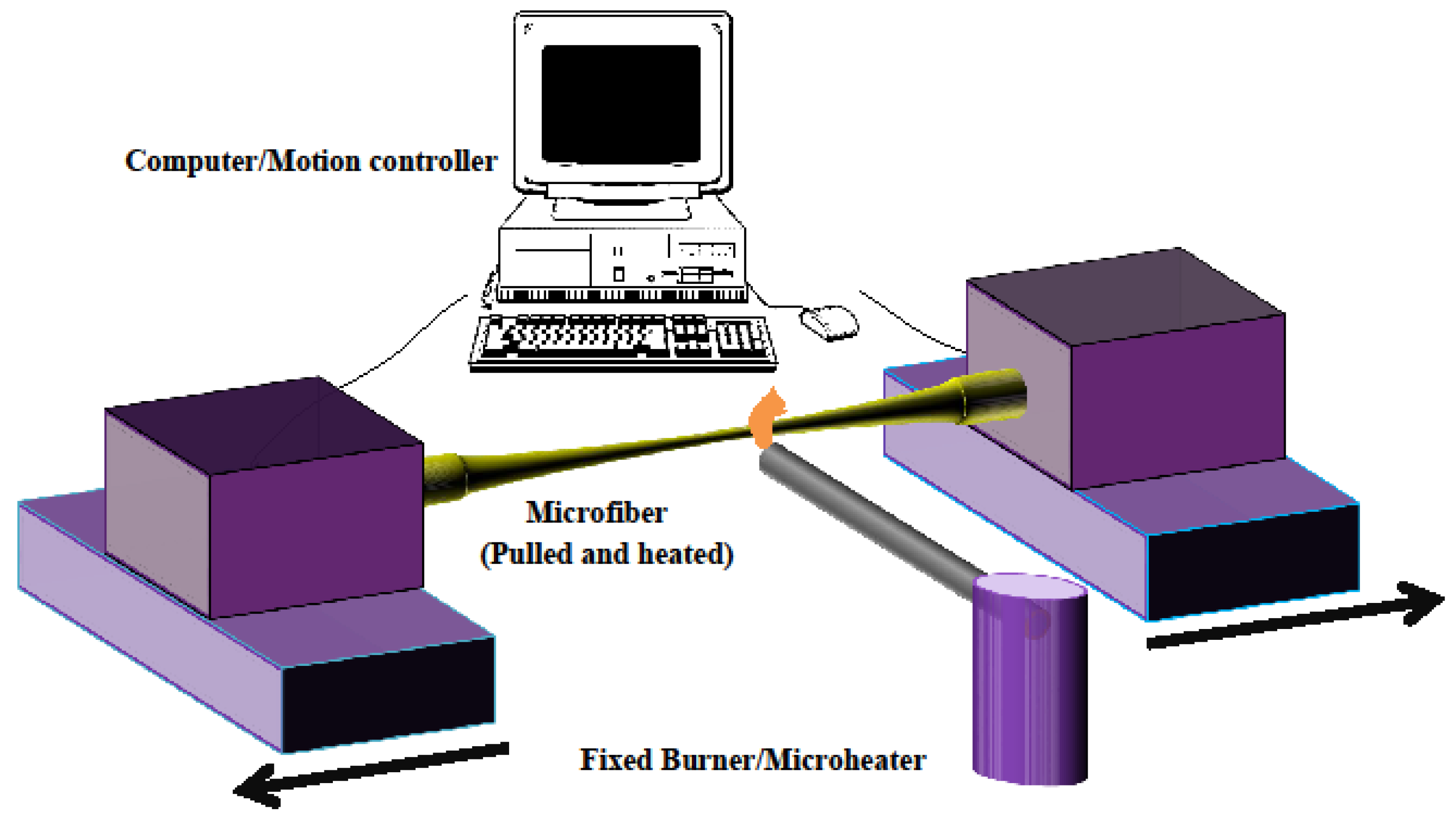
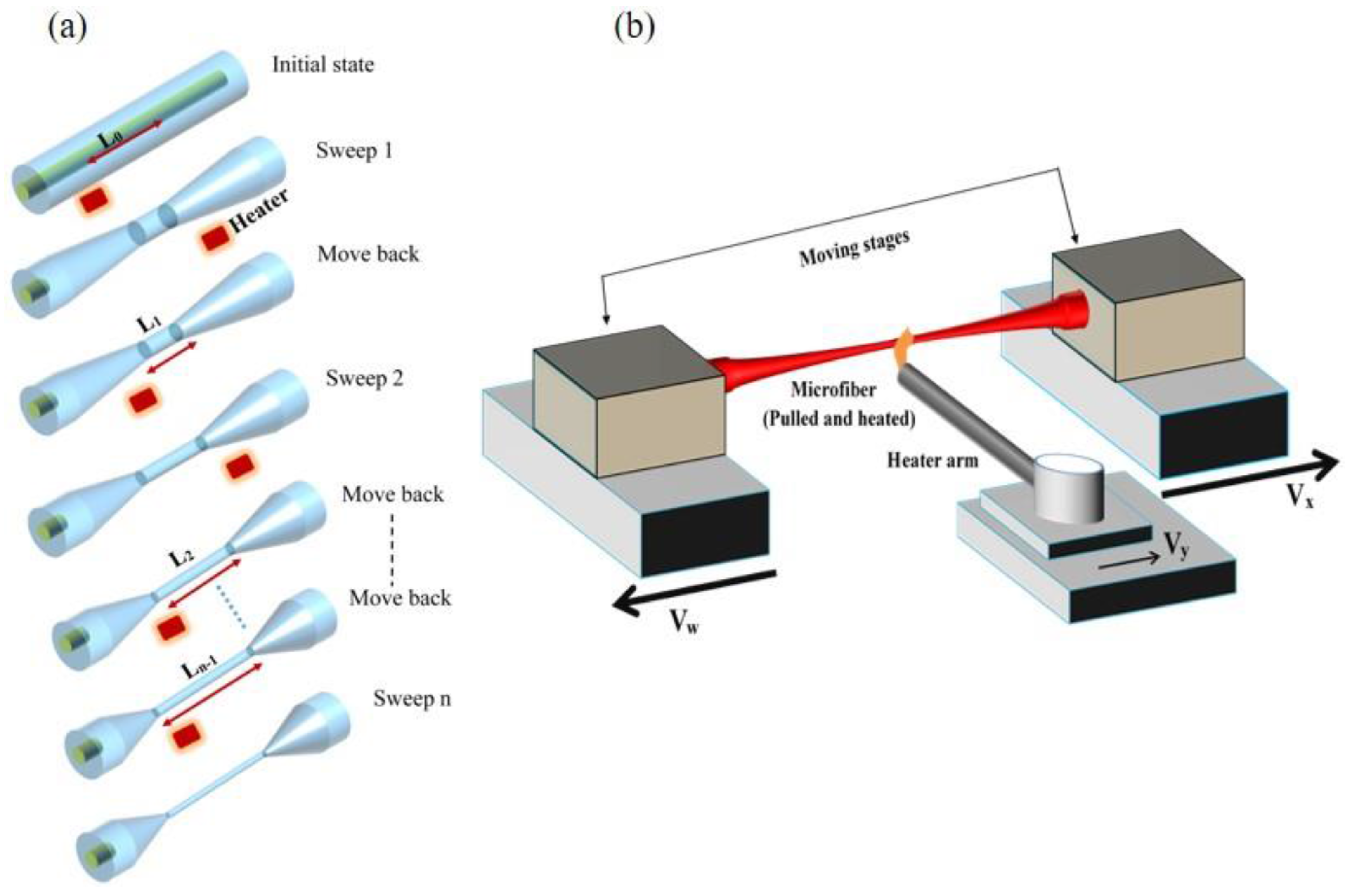
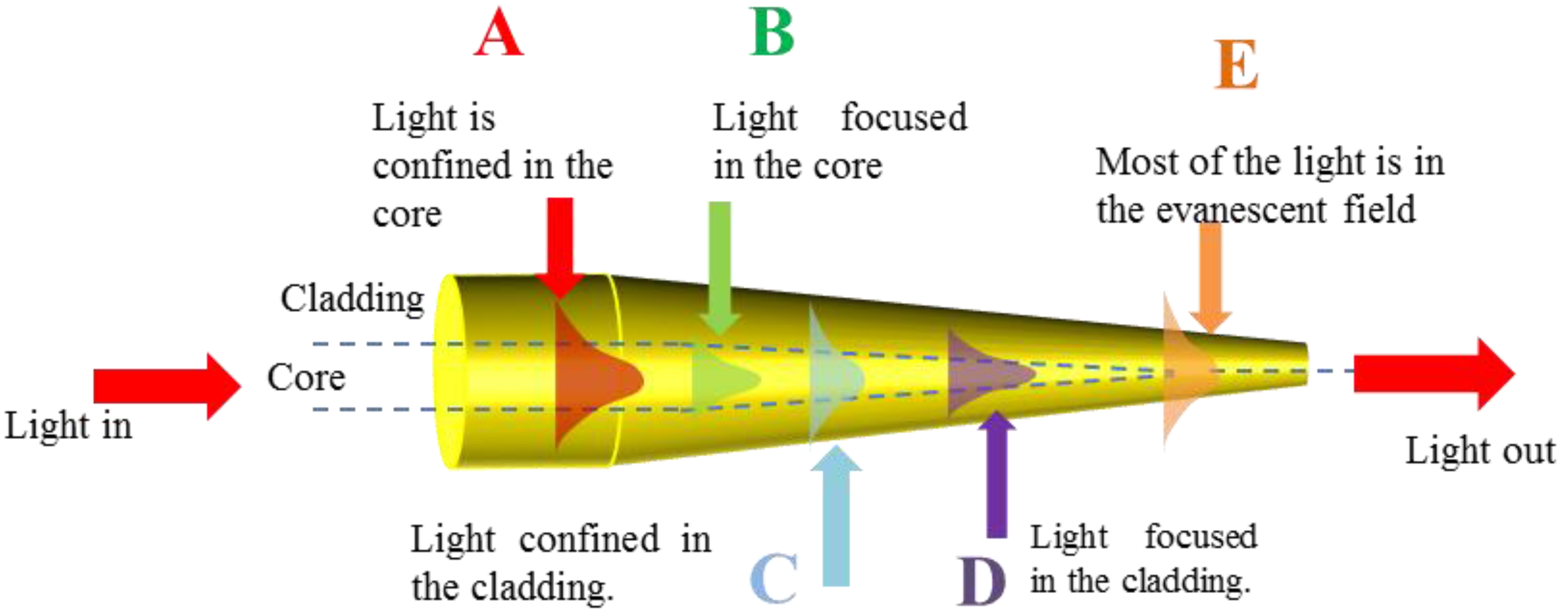
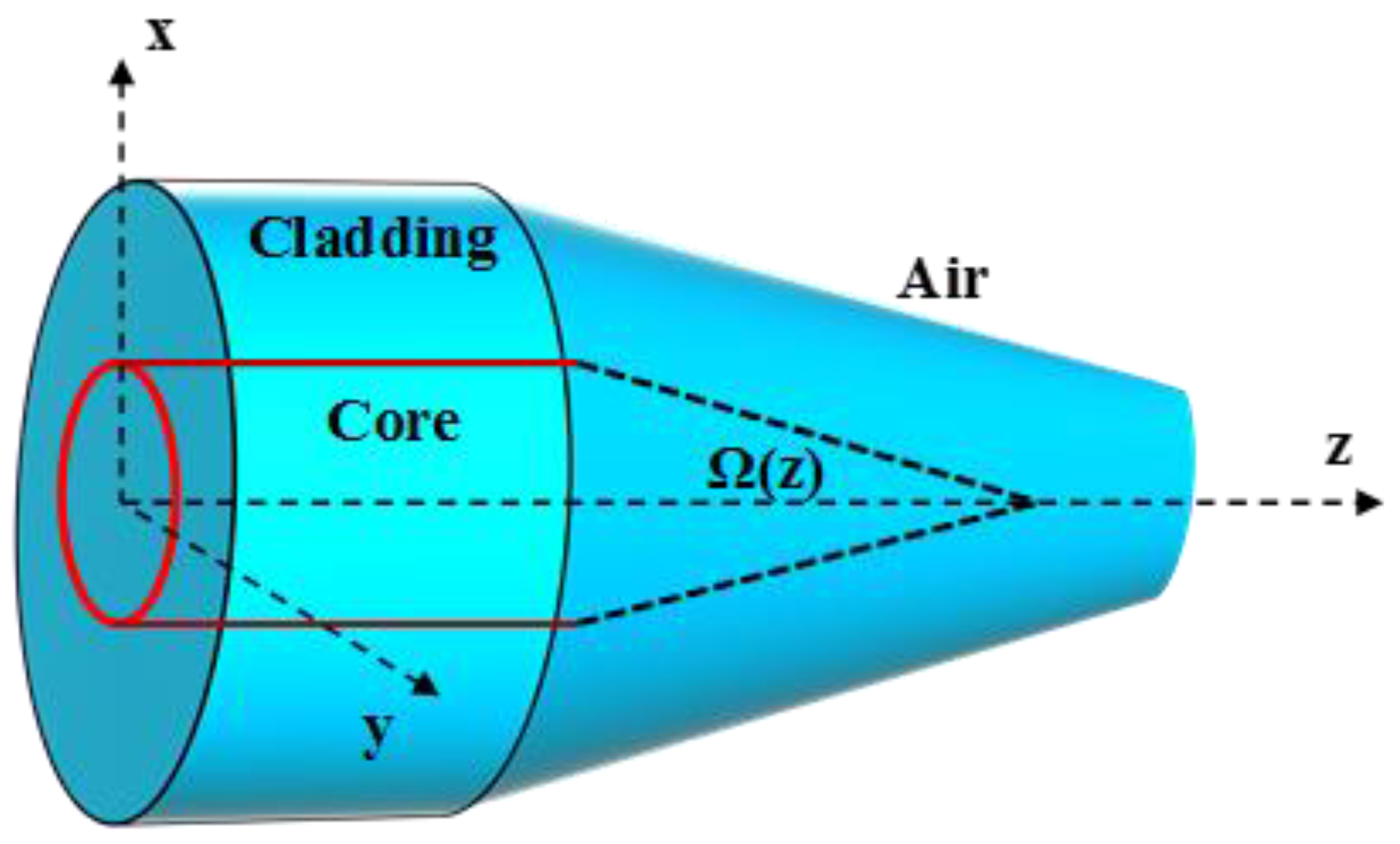

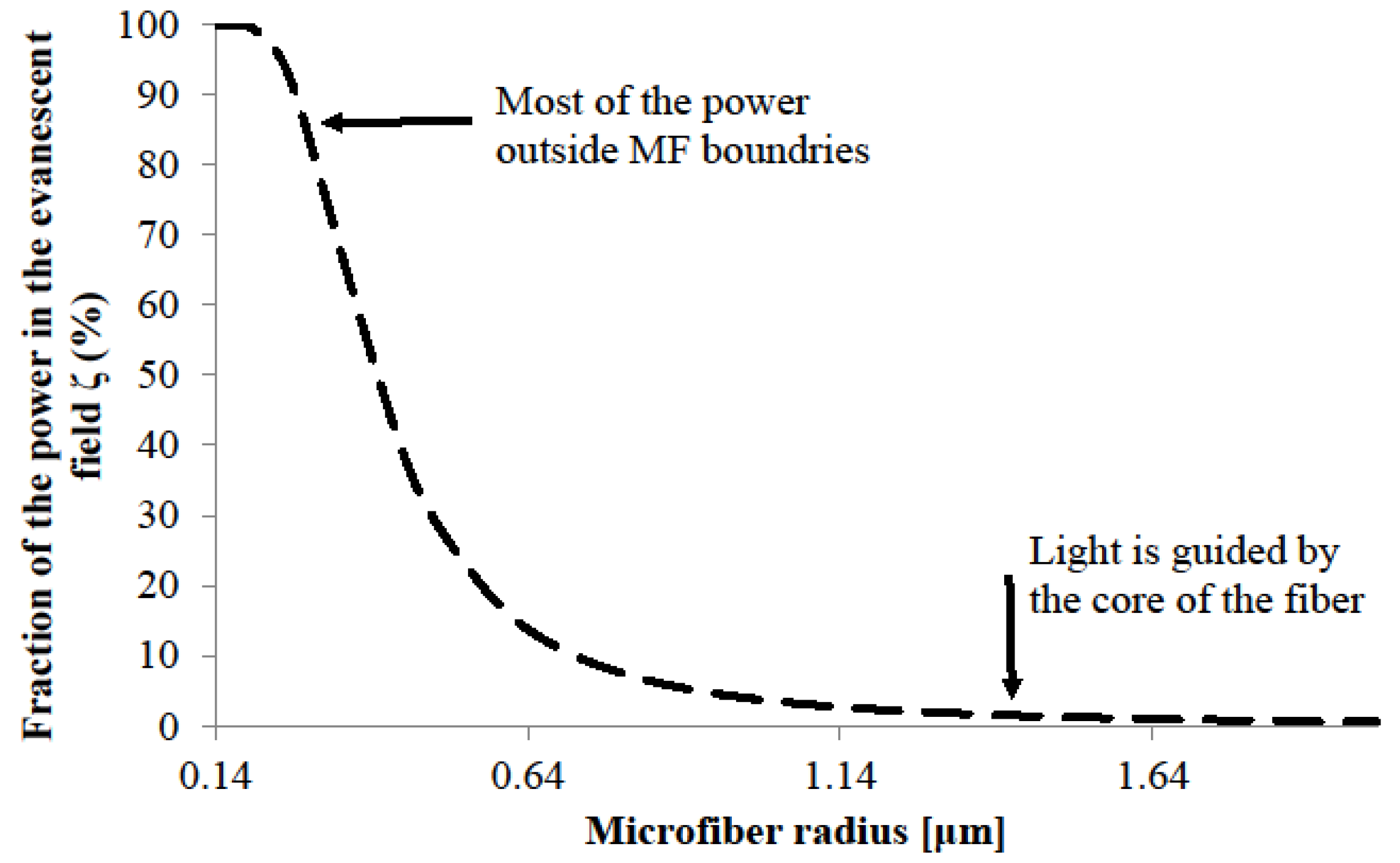

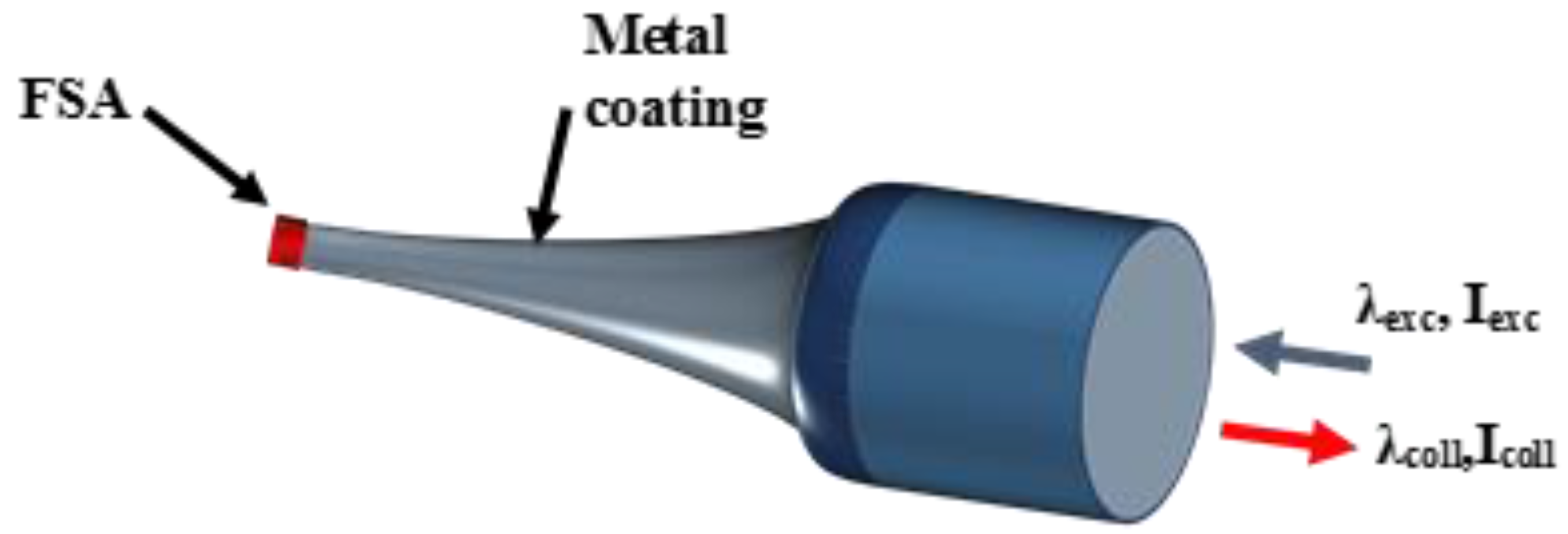


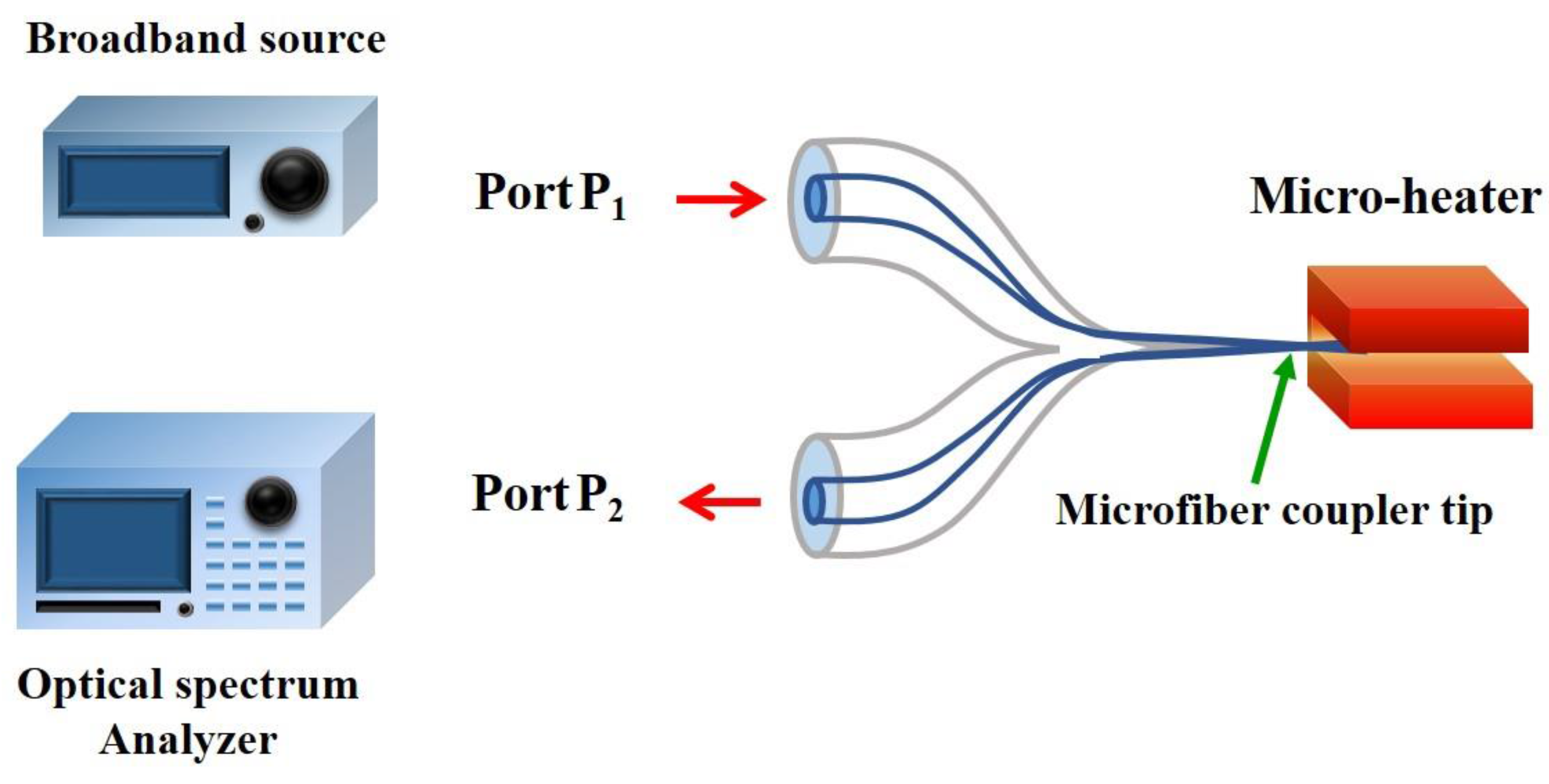
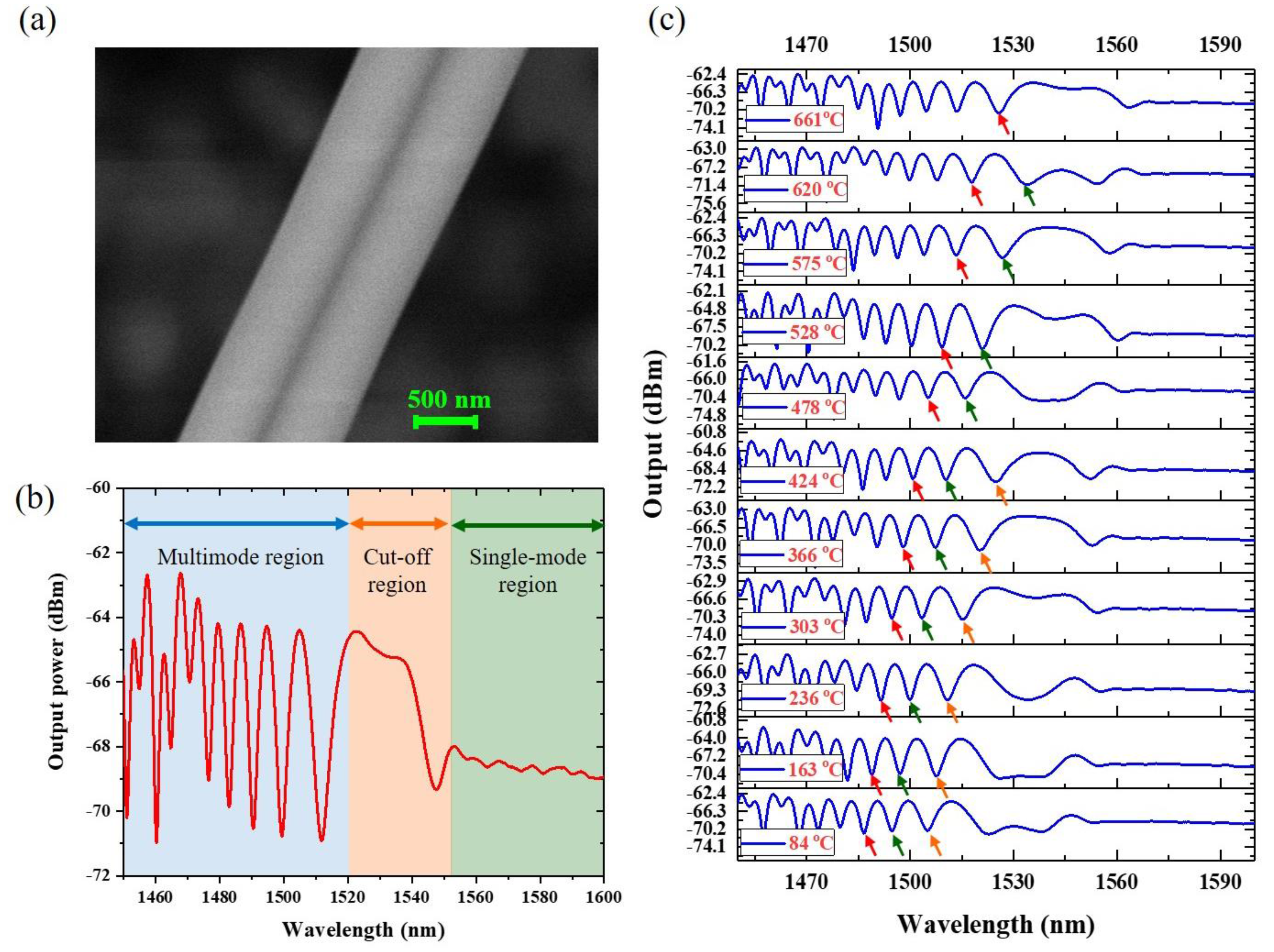
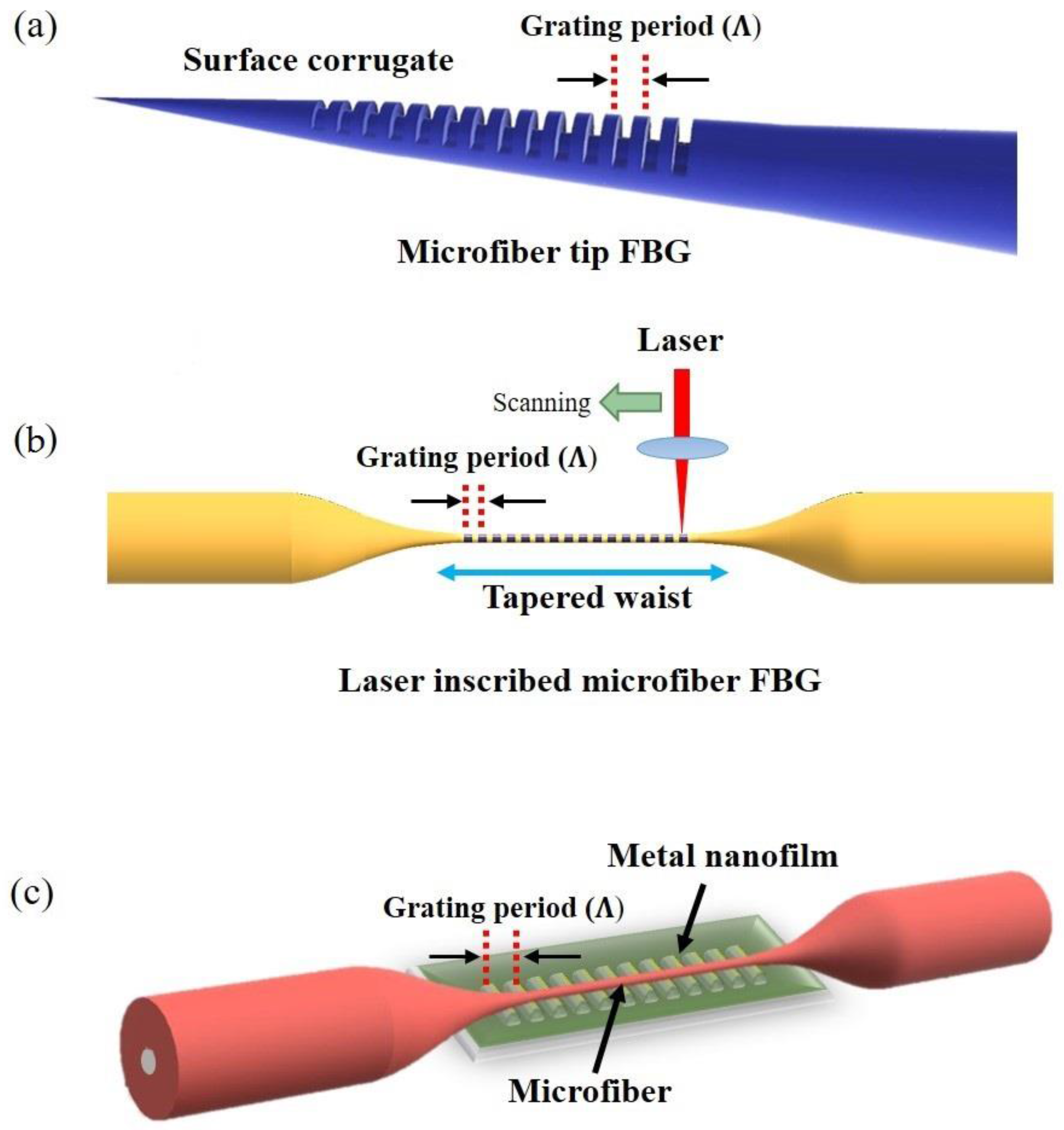

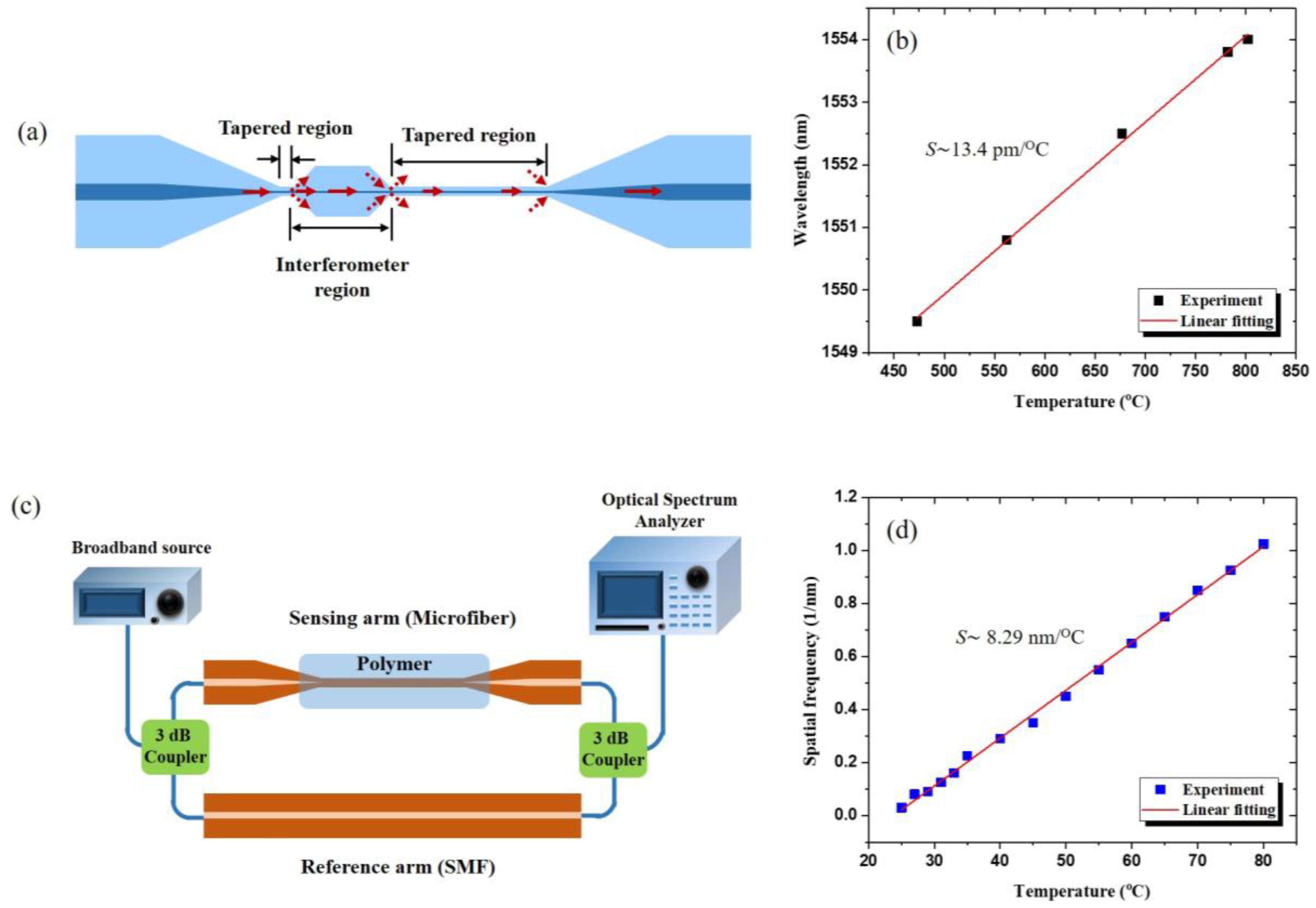
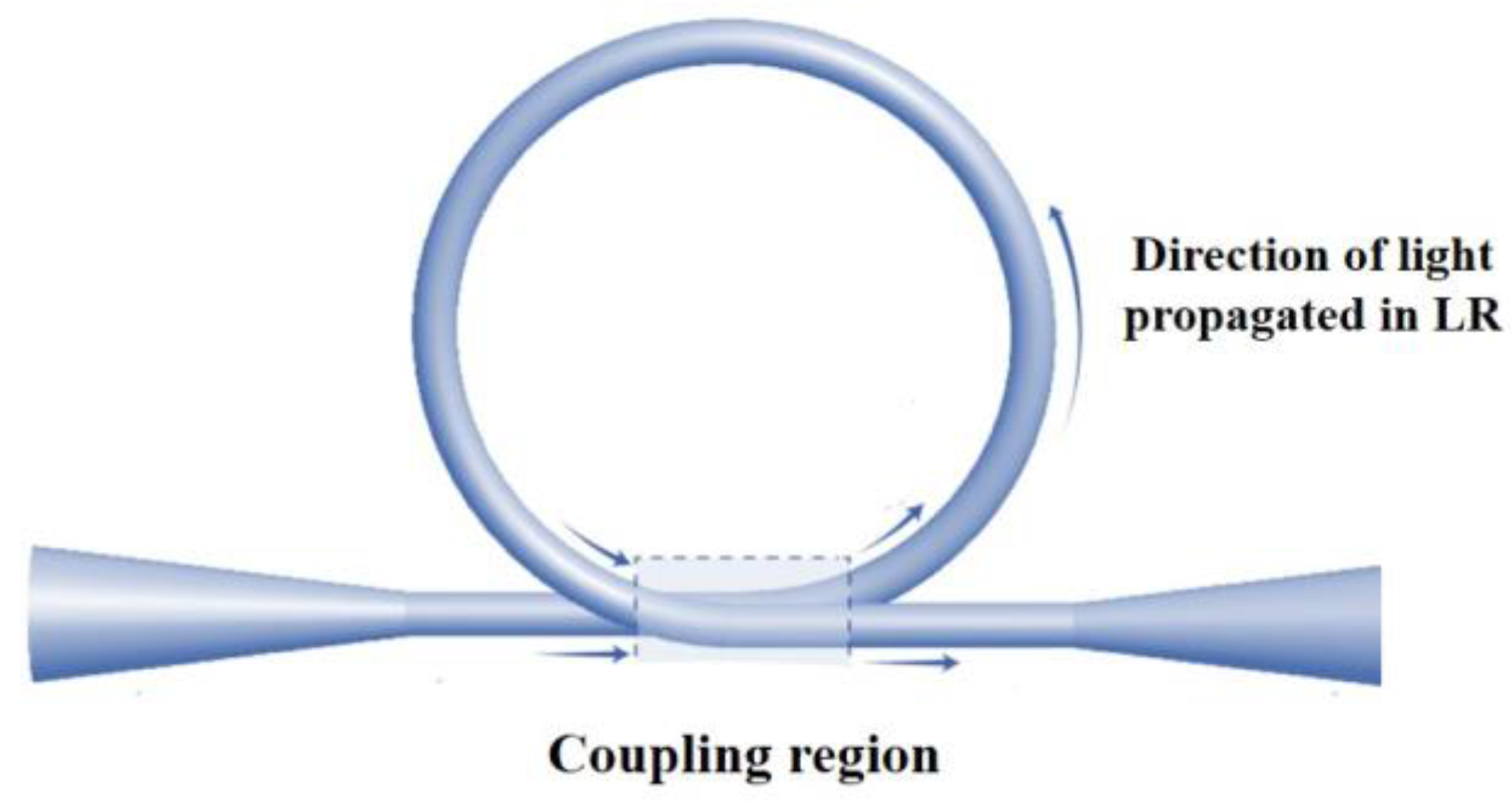
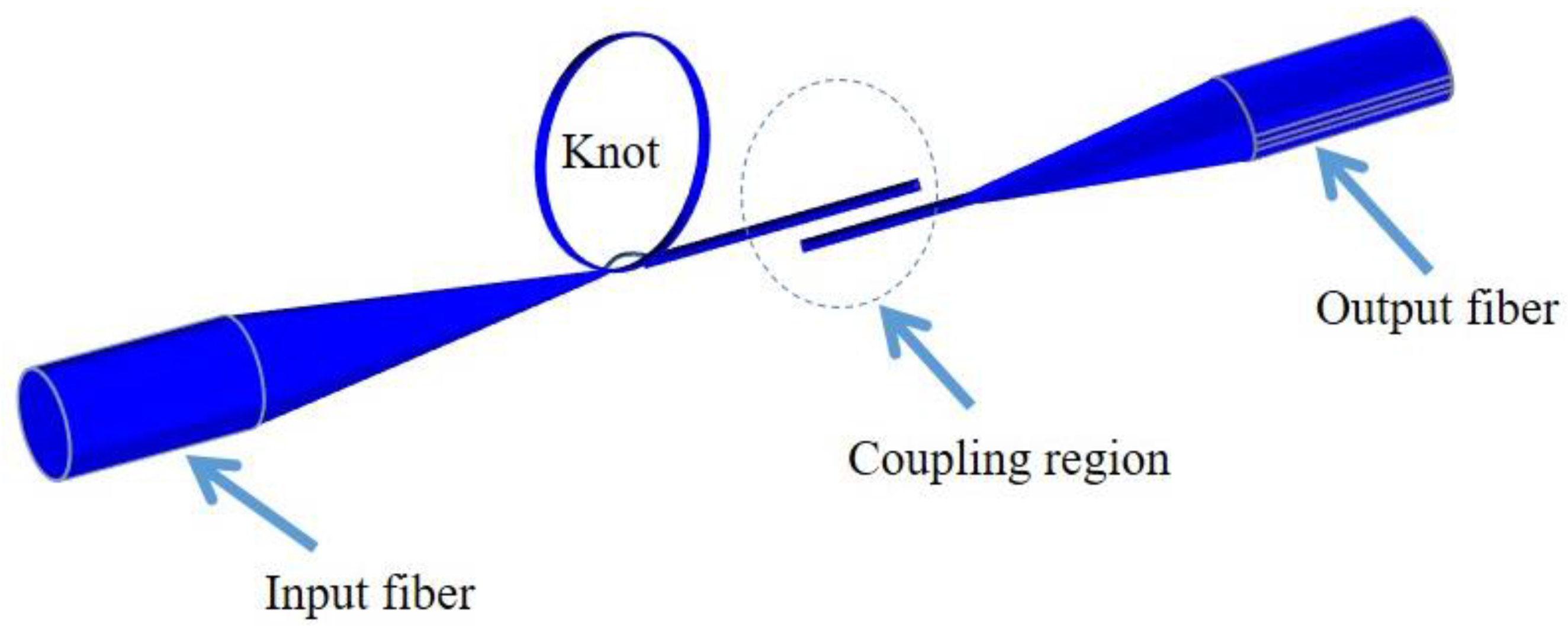


| Structure | Sensitivity | Temperature | Reference |
|---|---|---|---|
| MF | |||
| 1. MF coated thermochromic film | 0.043 dB/°C | 10–40 °C | [29] |
| 2. IPA filled MF | 3.88 nm/°C | 20–50 °C | [30] |
| 3. Non-adiabatic MF packed with PDMS | 3.102 nm/°C | 20–48 °C | [31] |
| 4. Metal coated MF | 2.44 nm/°C | 20–120 °C | [33] |
| 5. Graphene assisted MF | 0.1052 dB/°C | 30–80 °C | [35] |
| MFC | |||
| 6. Sol-gel coated MFC | 0.17 nm/°C | −50–100 °C | [51] |
| 7. MFC filled with water + glycerin | 1.5 nm/°C | 25–60 °C | [53] |
| 8. Liquid crystal coated MFC | 0.7 nm/°C | 20–70 °C | [54] |
| 9. Polyimide coated MFC Seawater temp | 1.17 nm/°C | 0–35 °C | [55] |
| 10. Ethyl cellulose ethoce(EC) coated MFC | 1.13 nm/°C | 17–31.6 °C | [56] |
| 11. MFC infilled with RI matching liquid using Teflon tube | 5.3 nm/°C | 35–45 °C | [57] |
| 12. Pure silica MFC | 31.1 pm/°C | 701–1029 °C | [59] |
| 13. Pure silica MFC tip | 11.96 pm/°C | 247–1283 °C | [50] |
| 14. Pure silica based NFC | 60 pm/°C | 84–661 °C | [62] |
| Gratings | |||
| 15. Encapsulated MFBG in metallic shield | 24–42 °C | [68] | |
| 16. Micromachining FBG on pure silica MF tip | 20 pm/°C | 21–440 °C | [69] |
| 17. Pure silica MFBG as end reflector | 9.7 pm/°C | 20–70 °C | [71] |
| 18. MFBG at MF tip | 22 pm/°C | 23–228 °C | [72] |
| 19. Concatenated SMF-MFBG_SMF coated with acetal | 479.48 pm/°C | 60–95 °C | [73] |
| 20. Coated silica thin film on MF | 62.9 nm/°C | 24.5–30 °C | [79] |
| 21. Periodic tapered MF LPG | 49.6 pm/°C | 30–180 °C | [80] |
| 22. PMMA coated LPG on top of MF | 385.11 pm/°C | 20–50 °C | [81] |
| 23. Mechanical induced MF LPG | 21 pm/°C | 400 °C | [82] |
| Interferometer | |||
| 24. MZI two fiber taper | 0.077 nm/°C | 20–60 °C | [83] |
| 25. FPI based micro-notch on aluminum coated MF tip | 20 pm/°C | 19–520 °C | [84] |
| 26. Two tapered formed MF MZI | 13.4 pm/°C | 800 °C | [85] |
| 27. Thin core fiber combine with waist enlarge fiber for fabricating microfiber MZI | 0.087 nm/°C | 1000 °C | [86] |
| 28. UV coated MF for fabricate MZI arm | 8.29 nm/°C | 25 °C | [87] |
| Loop | |||
| 29. Loop resonator | 26.5 pm/A | [95] | |
| 30. Resonance extinction ratio of LR | 0.043 dB/°C | [96] | |
| 31. Sagnac loop interferometer | 20.6 pm/°C | 30–130 °C | [97] |
| Knot | |||
| 32. Silica nnot resonator placed between two MgF2 plates | 52 pm/°C | 30–700 °C | [100] |
| 33. PMMA Knot resonator placed between two MgF2 plates | 266 pm/°C | 20–80 °C | [100] |
| 34. Embedded KR in fluoro-polymer | 270 pm/°C | 25–140 °C | [101] |
| 35. MKR for water temperature measurement | 25.1 pm/°C | 38–50 °C | [105] |
| MCR | |||
| 36. UV cure polymer coated on MCR coiled around teflon | 95 pm/°C | 80 °C | [109] |
© 2018 by the authors. Licensee MDPI, Basel, Switzerland. This article is an open access article distributed under the terms and conditions of the Creative Commons Attribution (CC BY) license (http://creativecommons.org/licenses/by/4.0/).
Share and Cite
Talataisong, W.; Ismaeel, R.; Brambilla, G. A Review of Microfiber-Based Temperature Sensors. Sensors 2018, 18, 461. https://doi.org/10.3390/s18020461
Talataisong W, Ismaeel R, Brambilla G. A Review of Microfiber-Based Temperature Sensors. Sensors. 2018; 18(2):461. https://doi.org/10.3390/s18020461
Chicago/Turabian StyleTalataisong, Wanvisa, Rand Ismaeel, and Gilberto Brambilla. 2018. "A Review of Microfiber-Based Temperature Sensors" Sensors 18, no. 2: 461. https://doi.org/10.3390/s18020461





